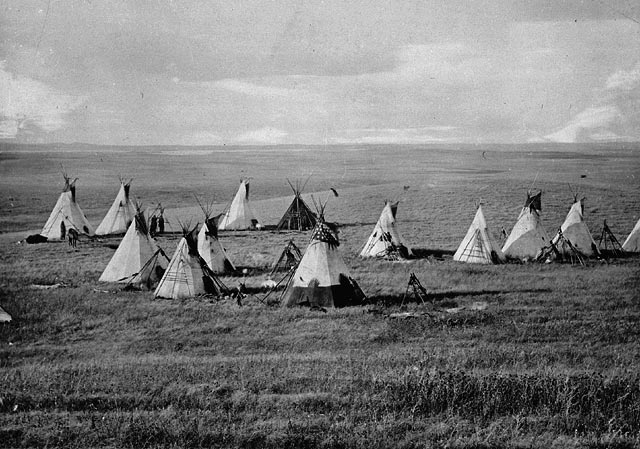|
Tamarack Geese
Tamarack geese are model birds made from twigs, traditionally created by the Cree as decoys to be used during their spring and fall hunts. They are made by gathering small twigs of the Larix laricina, Tamarack (''Larix laricina'') tree and tying them together around a central ball, also made of Larix laricina, Tamarack (''Larix laricina'') twigs using a thin brown string. While they are being made they are often held together by a thicker string which is later cut. The hole in the head of the decoy, when held against the snow, is meant to represent the white patch on the side of the head of Canada Geese The art of making these birds was beginning to fade, but in 1968 John Blueboy of Moose Factory, Ontario had the idea of reviving the practice by creating smaller versions to be sold as souvenirs. Since then, many artists and artisans have picked up the art. References Cree culture Decoys {{FirstNations-stub ... [...More Info...] [...Related Items...] OR: [Wikipedia] [Google] [Baidu] |
Cree
The Cree ( cr, néhinaw, script=Latn, , etc.; french: link=no, Cri) are a Indigenous peoples of the Americas, North American Indigenous people. They live primarily in Canada, where they form one of the country's largest First Nations in Canada, First Nations. In Canada, over 350,000 people are Cree or have Cree ancestry. The major proportion of Cree in Canada live north and west of Lake Superior, in Ontario, Manitoba, Saskatchewan, Alberta and the Northwest Territories. About 27,000 live in Quebec. In the United States, Cree people historically lived from Lake Superior westward. Today, they live mostly in Montana, where they share the Rocky Boy Indian Reservation with Ojibwe (Chippewa) people. The documented westward migration over time has been strongly associated with their roles as traders and hunters in the North American fur trade. Sub-groups / Geography The Cree are generally divided into eight groups based on dialect and region. These divisions do not necessarily r ... [...More Info...] [...Related Items...] OR: [Wikipedia] [Google] [Baidu] |
Larix Laricina
''Larix laricina'', commonly known as the tamarack, hackmatack, eastern larch, black larch, red larch, or American larch, is a species of larch native to Canada, from eastern Yukon and Inuvik, Northwest Territories east to Newfoundland, and also south into the upper northeastern United States from Minnesota to Cranesville Swamp, West Virginia; there is also an isolated population in central Alaska. The word ''akemantak'' is an Algonquian name for the species and means "wood used for snowshoes". Description ''Larix laricina'' is a small to medium-size boreal coniferous and deciduous tree reaching tall, with a trunk up to diameter. Tamaracks and larches (''Larix'' species) are deciduous conifers. The bark is tight and flaky, pink, but under flaking bark it can appear reddish. The leaves are needle-like, short, light blue-green, turning bright yellow before they fall in the autumn, leaving the pale pinkish-brown shoots bare until the next spring. The needles are produced spi ... [...More Info...] [...Related Items...] OR: [Wikipedia] [Google] [Baidu] |
Canada Geese
The Canada goose (''Branta canadensis''), or Canadian goose, is a large wild goose with a black head and neck, white cheeks, white under its chin, and a brown body. It is native to the arctic and temperate regions of North America, and it is occasionally found during migration across the Atlantic in northern Europe. It has been introduced to the United Kingdom, Ireland, Finland, Sweden, Denmark, New Zealand, Japan, Chile, Argentina, and the Falkland Islands. Like most geese, the Canada goose is primarily herbivorous and normally migratory; often found on or close to fresh water, the Canada goose is also common in brackish marshes, estuaries, and lagoons. Extremely adept at living in human-altered areas, Canada geese have established breeding colonies in urban and cultivated habitats, which provide food and few natural predators. The success of this common park species has led to its often being considered a pest species because of its excrement, its depredation of crops, its ... [...More Info...] [...Related Items...] OR: [Wikipedia] [Google] [Baidu] |
Moose Factory, Ontario
Moose Factory is a community in the Cochrane District, Ontario, Canada. It is located on Moose Factory Island, near the mouth of the Moose River, which is at the southern end of James Bay. It was the first English-speaking settlement in lands now making up Ontario and the second Hudson's Bay Company post to be set up in North America after Fort Rupert. On the mainland, across the Moose River, is the nearby community of Moosonee, which is accessible by water taxi in the summer, ice road in the winter, and chartered helicopter in the off-season (break-up or freeze-up). A private company also offers freighter-canoe ferry service across the Moose River. As of 2020, the MV Niska 1 ferry was operating between Moosonee and Moose Factory, carrying passengers and vehicles. The settlement is mainly inhabited by the Cree, but the hospital that provides healthcare services to the people of the island and surrounding area (collectively known as the Weeneebayko Area Health Authority) employs ... [...More Info...] [...Related Items...] OR: [Wikipedia] [Google] [Baidu] |
Cree Culture
The Cree ( cr, néhinaw, script=Latn, , etc.; french: link=no, Cri) are a North American Indigenous people. They live primarily in Canada, where they form one of the country's largest First Nations. In Canada, over 350,000 people are Cree or have Cree ancestry. The major proportion of Cree in Canada live north and west of Lake Superior, in Ontario, Manitoba, Saskatchewan, Alberta and the Northwest Territories. About 27,000 live in Quebec. In the United States, Cree people historically lived from Lake Superior westward. Today, they live mostly in Montana, where they share the Rocky Boy Indian Reservation with Ojibwe (Chippewa) people. The documented westward migration over time has been strongly associated with their roles as traders and hunters in the North American fur trade. Sub-groups / Geography The Cree are generally divided into eight groups based on dialect and region. These divisions do not necessarily represent ethnic sub-divisions within the larger ethnic group ... [...More Info...] [...Related Items...] OR: [Wikipedia] [Google] [Baidu] |

.jpg)

